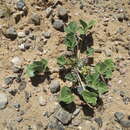Comprehensive Description
(
Anglèis
)
fornì da North American Flora
Pediomelum castoreum (S. Wats.) Rydberg
Psoralea castorea S. Wats. (; E. Palmer, Am. Nat. 12: 601; hyponym. 1878) Proc. Am. Acad. 14:
291. 1879. Lolodes castoreum Kuntze, Rev. Gen. 194. 1891.
A perennial, with a fusiform, farinaceous, tuberous root 5-8 cm. long, 1-3 cm. thick; stem very short, less than 1 dm. high, strigose-canescent, sometimes with decumbent branches 1 dm. long or more; leaves digitately 3-5-foliolate; stipules membranous, ovate, acute, 1 cm. long; petioles 5-10 cm. long; leaflets cuneate-obovate, rounded, acute, or even retuse at the apex, strigose-canescent beneath, sparingly strigose above, 2-4 cm. long; peduncles 3-5 cm. long; spikes dense, 2-4 cm. long; bracts ovate, lanceolate, or oblong, acute or obtuse, 5 mm. long or less; calyx canescent-strigose; tube 2 mm. long; upper four lobes subulate, attenuate, 7-8 mm. long, the lowest one spatulate or obovate, rounded or obtuse at the apex, about 10 mm. long; corolla blue, fully 1 cm. long; banner oblong; body of the pod ovoid, 8 mm. long, the flat attenuate beak 14-15 mm. long; seed 7 mm. long, flattened, transversely wrinkled, lightbrown.
Type locality: Near Beaver City, Utah [according to Watson, but Palmer, loc. cit., gives the locality as "between Beaver Dam, Arizona, and Saint Thomas, Nevada."].
Distribution: Southern Utah and Nevada, Arizona, and southern California.
- sitassion bibliogràfica
- Per Axel Rydberg. 1919. (ROSALES); FABACEAE; PSORALEAE. North American flora. vol 24(1). New York Botanical Garden, New York, NY
Physical Description
(
Anglèis
)
fornì da USDA PLANTS text
Perennial, Herbs, Stems woody below, or from woody crown or caudex, Plants with rhizomes or suckers, Taproot present, Tubers or tuberous roots present, Nodules present, Stems very short, acaulescent or subacaulescent, Stems or branches arching, spreading or decumbent, Stems less than 1 m tall, Plants gland-dotted or with gland-tipped hairs, Stems solid, Stems or young twigs glabrous or sparsely glabrate, Stems or young twigs sparsely to densely hairy, Stems silvery, canescent, tomentose, cobwebby, or wooly, Leaves alternate, Leaves clustered on spurs or fasicles, Leaves petiolate, Stipul es conspicuous, Stipules green, triangulate to lanceolate or foliaceous, Stipules setiform, subulate or acicular, Stipules persistent, Stipules free, Leaves compound, Leaves palmately 5-11 foliate, Leaf or leaflet margins entire, Leaflets 5-9, Leaves glandular punctate or gland-dotted, Leaves hairy on one or both surfaces, Inflorescences racemes, Inflorescences spikes or spike-like, Inflorescence axillary, Bracts conspicuously present, Bracts hairy, Flowers zygomorphic, Calyx 5-lobed, Calyx hairy, Petals separate, Corolla papilionaceous, Petals clawed, Petals ochroleucous, cream colored, Petals blue, lavander to purple, or violet, Banner petal ovoid or obovate, Banner petal auriculate, Wing petals narrow, oblanceolate to oblong, Wing petals auriculate, Wing tips obtuse or rounded, Keel tips obtuse or rounded, not beaked, Stamens 9-10, Stamens diadelphous, 9 united, 1 free, Filaments glabrous, Style terete, Style hairy, Fruit a legume, Fruit unilocular, Fruit freely dehiscent , Fruit oblong or ellipsoidal, Fruit enclosed in calyx, Fruit beaked, Fruit hairy, Fruit 1-seeded, Seeds ovoid to rounded in outline, Seed surface wrinkled or rugose, Seeds olive, brown, or black.
Pediomelum castoreum: Brief Summary
(
Anglèis
)
fornì da wikipedia EN
Pediomelum castoreum is a species of flowering plant in the legume family known by the common names beaver Indian breadroot and beaver dam breadroot. It is native to the deserts around the intersection of California, Nevada, and Arizona, where it grows in local habitat including disturbed areas. It is a perennial herb with no stem or a short stem that is mostly underground, leaving the plant at ground level. The compound leaves are each made up of five or six oval leaflets which may be over 4 centimeters long. The leaf is borne on a long petiole. The inflorescence is a raceme of several blue or purple pealike flowers each roughly a centimeter long. The fruit is a hairy oval legume pod tipped with a long, curved beak. It contains ridged gray seeds each about 6 millimeters long.
- licensa
- cc-by-sa-3.0
- drit d'autor
- Wikipedia authors and editors

